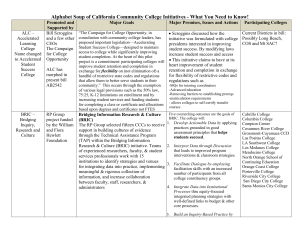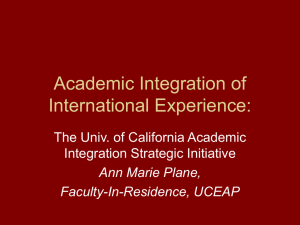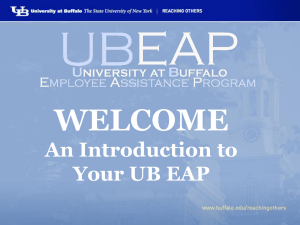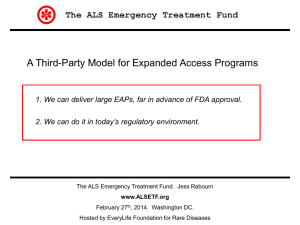California Community Colleges (CCC)
advertisement
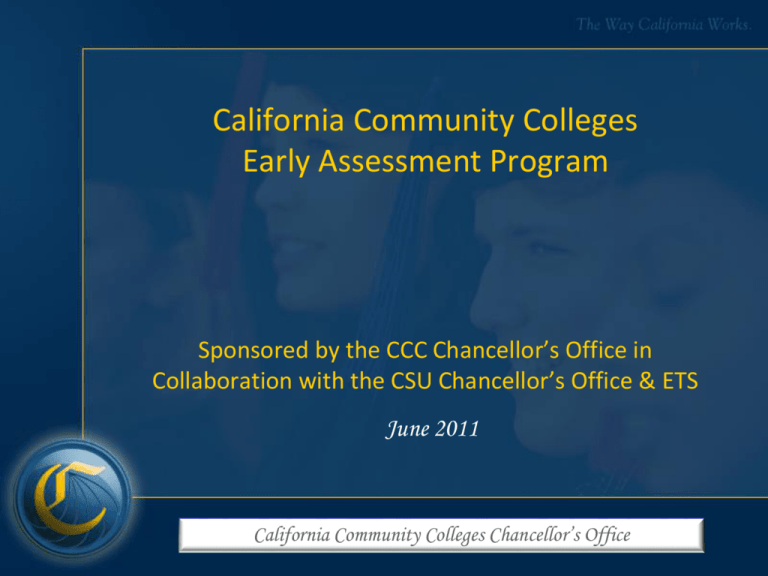
California Community Colleges Early Assessment Program Sponsored by the CCC Chancellor’s Office in Collaboration with the CSU Chancellor’s Office & ETS June 2011 California Community Colleges Chancellor’s Office CCC Strategic Plan Described in Goal B: Student Success & Readiness • B2 - Assessment and Placement Better coordination and articulation with K–12 is needed to improve student success. The EAP is an opportunity to engage with high schools and CSU to improve preparation. Implemented in Goal A: College Awareness & Access • A1 - Early Awareness of College as a Viable Option In late 2006, began working to obtain legislation to support CCC collaboration in the CSU EAP. California Community Colleges Chancellor’s Office Senate Bill 946 • Signed by Governor September 28, 2008 • Authorizes the System Office and community colleges to implement EAP and to access data • CCC’s to use existing EAP framework established by CSU & CDE • No new funds • Community colleges can volunteer to administer EAP • Authorizes community college districts to use EAP results for assessment and placement purposes California Community Colleges Chancellor’s Office CCC Chancellor’s Office Role • Collaborate & coordinate EAP implementation with CDE and CSU Chancellor’s Office • Authorized to receive EAP data and provide data to participating community colleges • Coordinate community college EAP efforts • Provide technical assistance to community colleges • Establish reporting requirements • Submit report to Legislature & Governor on EAP implementation progress & results by February 15, 2015 California Community Colleges Chancellor’s Office Why Participate in EAP? • Allows colleges to focus limited assessment funding on students who may not be ready for college-level coursework • Sends a strong college readiness message to CA’s high school juniors and seniors • Access to high school student EAP data for outreach, placement, and research purposes • For those students indicating an interest in attending college, partnering with high schools & CSU to help students prepare before they graduate could reduce need for basic skills coursework later California Community Colleges Chancellor’s Office CCC EAP Participation Levels 1. Use of EAP Test Results for placement of students demonstrating college readiness in English and/or math; a. b. c. d. Effective January 1, 2009 No application or CCCCO approval necessary Survey of colleges accepting EAP results on CCCCO website: www.cccco.edu/eap As of June 2011, 51 community colleges are accepting EAP results and many more are in discussion to adopt EAP 2. Program-level Participation California Community Colleges Chancellor’s Office Community College Program-Level Participation In order to participate, colleges must submit application/plan to the System Office and: • Identify an EAP Coordinator to work with CSU and local K12 districts • Serve students within district boundary • Use existing EAP infrastructure of academic opportunities (ERWC, etc.) • Use EAP results for placement of students demonstrating college readiness in English and/or math • Meet Chancellor’s Office reporting requirements California Community Colleges Chancellor’s Office CCC EAP Implementation Plans Passage of SB 946 Convene State CCC Implementation Advisory Committee Coordinate CCC EAP Technical Workgroup: • • • • Application/plan process Websites Outreach Application & Selection of Participating EAP Colleges Inclusion of Community Colleges on State Testing Forms and High School Student/Administrator Notification Letters Related to EAP Launch College EAP Website (www.collegeEAP.org) Develop Outreach Materials California Community Colleges Chancellor’s Office Implementation Plan Milestones EAP Application released: Nov 2009 Forms & notification letters include CCC’s: Fall 2009 Community colleges identified to participate: Jan 2010 CCC EAP begins 2009-10 academic year 11th grade students take EAP that includes CCC’s: Spring 2010 Community colleges receive EAP data: January 2011 California Community Colleges Chancellor’s Office EAP Timeline February: 11th grade students notified about EAP test opportunity Spring: 11th grade students can opt to take EAP August : EAP results sent to students on STAR report at beginning of 12th grade year September: EAP data made available to CSU & CCC’s California Community Colleges Chancellor’s Office New 11th Grade California Standardized Test Language Spring 2010 “IMPORTANT: By answering the questions in this section, I acknowledge that I am voluntarily participating in the Early Assessment Program (EAP). I understand that I may request that my EAP and CST results be released to any postsecondary institution(s) in which I seek or intend to enroll. By marking only one of the following circles below, I affirm that I intend to seek or enroll in California State University (CSU) or California Community Colleges (CCC) or both, and understand that my English EAP and CST results will be shared directly with CSU and or CCC officials as indicated below. Mark only one circle: CSU CCC CSU and CCC California Community Colleges Chancellor’s Office Release of Test Results to CCC or CSU Authorizing Releases # of Students % of Students EAP English 375,456 Students releasing to CSU only 35,447 9% Students releasing to CCC only 25,634 7% Students releasing to both 223,781 60% Students releasing to neither 90,594 24% Total # released to CSU 259,228 69% Total # released to CCC 249,415 66% Total # released to overall 284,862 76% Authorizing Releases # of Students % of Students EAP Math 178,611 Students releasing to CSU only 22,912 13% Students releasing to CCC only 8,079 5% Students releasing to both 121,033 68% Students releasing to neither 26,587 15% Total # released to CSU 143,945 81% Total # released to CCC 129,112 72% Total # released to overall 152,024 85% California Community Colleges Chancellor’s Office EAP Research CSUS EAP Research Study on student EAP participation & effect on need for remedial coursework in college (April 2009): •Researchers found that participation in EAP reduces the probability of remediation at CSUS •by 6.2 percentage points in English •by 4.3 percentage points in math Achieve’s American Diploma Project content analysis of EAP (October 2009): •The EAP assessments address college-ready content identified by CSU faculty for entering credit-bearing coursework •The EAP augmentations provide rigor and contribute to authentic college readiness tasks for the assessment of a students’ college preparation California Community Colleges Chancellor’s Office Future Research CCCCO planning future research to analyze EAP student participation and outcomes related to: •Enrollment in a community college •Courses taken •Assessment •Course completion and success rate California Community Colleges Chancellor’s Office The Early Assessment Program, the Common Core State Standards, & Centralized Assessment California Community Colleges Chancellor’s Office The Common Core State Standards (CCSS) • Rigorous, research-based standards for English-language arts and mathematics for grades K-12 • Designed to prepare students with the knowledge and skills needed for success in college and the workforce • August 2010: State Board of Education adopted the CCSS • September 2010: Two assessment consortia funded • Partnership for Assessment Readiness for College & Career • Smarter Balanced Assessment Consortia • May 2011: State Board of Education supports Smarter Balanced • What does the Common Core mean for the CCCs? California Community Colleges Chancellor’s Office Smarter Balanced 2010 – 2012 Development of formative tools, processes, practices, and professional development begins 2013 Review of screened state-owned item and development of new summative and interim items 2012 Interim item pool becomes available for use 2013 Field testing January 2015 Operational summative assessments available August 2015 Adoption of common achievement standards California Community Colleges Chancellor’s Office • For more information about the Common Core: • California Department of Education: • http://www.cde.ca.gov/ci/cc/ • Common Core State Standards Initiative: • http://www.corestandards.org/ California Community Colleges Chancellor’s Office EAP & Centralized Assessment • • A centrally managed assessment administration system • • • • • One uniform assessment instrument for each curricular area of math, English and English as a second language available to all CCCs A central data warehouse to collect and store assessment and placement data. Assessments available to all colleges at a centrally negotiated and reduced rate. Resolution 15.03 - Baseline indicator (single statewide cut scores) on centralized assessment instruments would provide clarity of messaging Colleges would still have local autonomy as to how to best address developmental and remedial needs California Community Colleges Chancellor’s Office CCCAssess Timeline April-May 2010 Input from discipline and counseling faculty and matriculation and assessment staff on assessment test needs July 2010 Draft RFI Completed July –August 2010 Draft RFI team review August 2010 RFI Released November 30, 2010 Completed vendor proposals due January 2011 RFI evaluations completed March 2011 Feasibility study completed California Community Colleges Chancellor’s Office Future Goals and Plans for CCCAssess •AB 743 (Block) CCC Common Assessment •Goal to secure funding for CCCAssess by summer 2011 •Proposed release of RFP summer •Fall 2011: RFP process completed •Spring 2012: test development, testing, pilot •Summer 2012: Implement CCCAssess California Community Colleges Chancellor’s Office Thank you. California Community Colleges Chancellor’s Office



